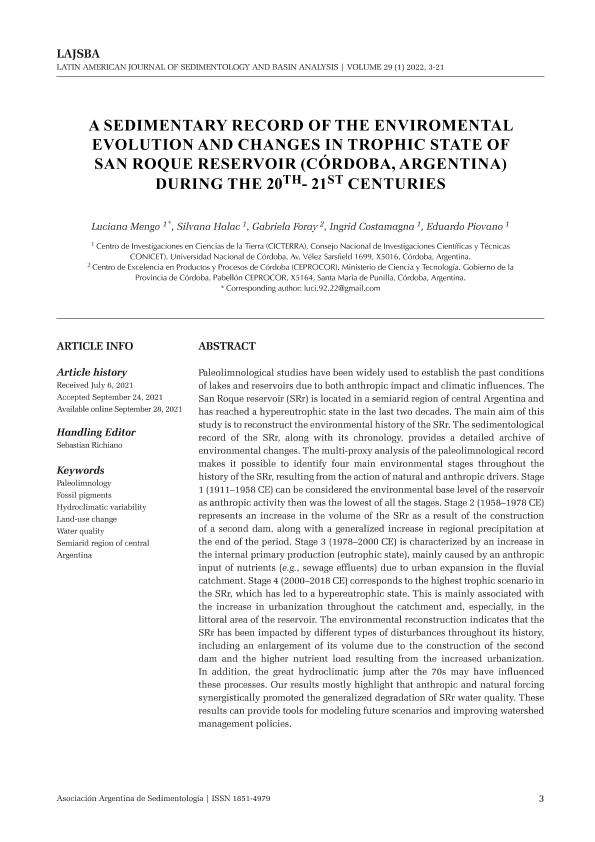Artículo
A sedimentary record of the environmental evolution and changes in trophic state of San Roque reservoir (Córdoba, Argentina) during the 20th–21st centuries
Mengo, Luciana del Valle ; Halac, Silvana Raquel
; Halac, Silvana Raquel ; Foray, Silvia Gabriela; Costamagna, Ingrid
; Foray, Silvia Gabriela; Costamagna, Ingrid ; Piovano, Eduardo Luis
; Piovano, Eduardo Luis
 ; Halac, Silvana Raquel
; Halac, Silvana Raquel ; Foray, Silvia Gabriela; Costamagna, Ingrid
; Foray, Silvia Gabriela; Costamagna, Ingrid ; Piovano, Eduardo Luis
; Piovano, Eduardo Luis
Fecha de publicación:
01/2022
Editorial:
Asociación Argentina de Sedimentología
Revista:
Latin American Journal of Sedimentology and Basin Analysis
ISSN:
1669-7316
e-ISSN:
1851-4979
Idioma:
Inglés
Tipo de recurso:
Artículo publicado
Clasificación temática:
Resumen
Paleolimnological studies have been widely used to establish the past conditions of lakes and reservoirs due to both anthropic impact and climatic influences. The San Roque reservoir (SRr) is located in a semiarid region of central Argentina and has reached a hypereutrophic state in the last two decades. The main aim of this study is to reconstruct the environmental history of the SRr. The sedimentological record of the SRr, along with its chronology, provides a detailed archive of environmental changes. The multi-proxy analysis of the paleolimnological record makes it possible to identify four main environmental stages throughout the history of the SRr, resulting from the action of natural and anthropic drivers. Stage 1 (1911–1958 CE) can be considered the environmental base level of the reservoir as anthropic activity then was the lowest of all the stages. Stage 2 (1958–1978 CE) represents an increase in the volume of the SRr as a result of the construction of a second dam, along with a generalized increase in regional precipitation at the end of the period. Stage 3 (1978–2000 CE) is characterized by an increase in the internal primary production (eutrophic state), mainly caused by an anthropic input of nutrients (e.g., sewage effluents) due to urban expansion in the fluvial catchment. Stage 4 (2000–2018 CE) corresponds to the highest trophic scenario in the SRr, which has led to a hypereutrophic state. This is mainly associated with the increase in urbanization throughout the catchment and, especially, in the littoral area of the reservoir. The environmental reconstruction indicates that the SRr has been impacted by different types of disturbances throughout its history, including an enlargement of its volume due to the construction of the second dam and the higher nutrient load resulting from the increased urbanization. In addition, the great hydroclimatic jump after the 70s may have influenced these processes. Our results mostly highlight that anthropic and natural forcing synergistically promoted the generalized degradation of SRr water quality. These results can provide tools for modeling future scenarios and improving watershed management policies.
Palabras clave:
PALEOLIMNOLOGY
,
FOSSIL PIGMENTS
,
HYDROCLIMATE VARIABILITY
,
LAND USE CHANGE
Archivos asociados
Licencia
Identificadores
Colecciones
Articulos(CICTERRA)
Articulos de CENTRO DE INVEST.EN CS.DE LA TIERRA
Articulos de CENTRO DE INVEST.EN CS.DE LA TIERRA
Citación
Mengo, Luciana del Valle; Halac, Silvana Raquel; Foray, Silvia Gabriela; Costamagna, Ingrid; Piovano, Eduardo Luis; A sedimentary record of the environmental evolution and changes in trophic state of San Roque reservoir (Córdoba, Argentina) during the 20th–21st centuries; Asociación Argentina de Sedimentología; Latin American Journal of Sedimentology and Basin Analysis; 29; 1; 1-2022; 3-21
Compartir



